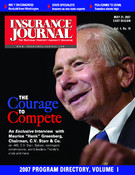The 400 insurers of the American Insurance Association have seen the favorable results for the public as well as insurers when states have worked to increase competition and relax unproductive regulatory restraints. Recent legislation in Massachusetts (H. 1023) makes great strides in this area for the state’s private passenger auto insurance market.
The state’s “fix and establish” system has resulted in fewer companies, less consumer choice and higher residual market placements. In connection with an AEI-Brookings seminar, Professors Tennyson, Weiss and Regan studied the Massachusetts auto system through the 1980s and 1990s and concluded that:
“Our analysis of the impact of this system on the automobile insurance market shows that the number of insurance suppliers is reduced and the character of suppliers is distorted toward smaller, single state insurers. The residual market is larger than would be expected under competition, and insurance loss costs are higher than can be explained by market conditions alone. Simultaneously, insurer rates of return remain low under the regulatory system.”
Lack of competition
One measure of competition is the Herfindahl-Hirschman Index (HHI). For 2005, the Massachusetts score of 1,371 far exceeds that of its neighboring states. For example, the HHI for Connecticut is 653; for New Hampshire, 754; for Rhode Island, 806. Even New York only scores 994. The numbers suggest that the auto insurance markets in all New England states are far less concentrated and far more competitive than in Massachusetts. Massachusetts has far fewer players in its auto insurance market and those that are in the market have a greater concentrated share than in adjoining states.
The trend globally and in the U.S. is to encourage competition through regulatory modernization, including allowing prices to reflect underlying costs and marketplace conditions. While about half of the states require “prior approval” of auto insurance rates, only Massachusetts directly sets rates by “fixing and establishing” a rate for use by all carriers.
University of South Carolina Professor Scott Harrington, after studying prior approval, concluded that: “…prior approval is reliably associated with lower availability of coverage. It is positively and significantly related to residual market shares. …Prior approval regulation is also reliably associated with greater volatility in loss ratios and expenditure growth rates …”
Wharton Professor David Cummins wrote: “… in the long run, rate regulation does not significantly reduce prices for consumers. However, it generally reduces the quality and variety of services available to consumers. The system also subsidizes high-cost drivers, sending adverse incentive signals and increasing accident costs. Regulation also increases cash flow volatility for insurers, raising the cost of capital. In essence, regulation creates material economic inefficiencies in order to provide cross-subsidies to the drivers who impose the highest costs on state automobile insurance systems.”
The actual experience in Massachusetts, unfortunately, is consistent with the literature. The remedy is to move toward a more pro-competitive model.
The solution
Until recently, New Jersey heavily regulated its auto insurance marketplace and that policy produced many of the same ills that plague the Massachusetts system. New Jersey recently overhauled its regulatory approach with remarkable results. A number of new companies entered the market resulting in the strongest competitive environment and greatest choice that consumers have witnessed in many years. An editorial that ran in the largest newspaper in the state, the Star-Ledger, on April 23, 2005, noted:
“When was the last time car insurance companies aggressively solicited new business in New Jersey or tried to convince drivers to switch? It was so long ago that few driving today can remember. But now letters from competing companies arrive in the mail, and billboards and newspaper ads lure drivers with promises of more coverage for less.”
These same benefits could be realized by Massachusetts drivers through the proposed reforms. While not ideal, H. 1023 does address the core problems in Massachusetts by allowing more flexibility in rating and underwriting, reforming the unfair involuntary market system (Commonwealth Auto Reinsurers) and reducing costs caused by preventable injuries and fraud. Ultimately, its enactment should encourage more competition, provide more choice to consumers and set up conditions for lower costs for everyone.
The bill’s most significant pro-competitive reform is that it gradually relaxes the “one size fits all” rating system through the use of flex bands, which has worked well in New Jersey and elsewhere as an interim measure to provide pricing flexibility for insurers while still guarding against dramatic swings in prices. Although flex rating is still far away from full market-based pricing, it should encourage more market players to enter Massachusetts.
- The bill also replaces Massachusetts’ inequitable and Byzantine residual market mechanism with a sensible assigned risk plan like that in most other states. Reforming the residual market, coupled with a competitive pricing system, will modernize the Massachusetts marketplace and afford consumers choices enjoyed by those in other states.
- Massachusetts consumers deserve more choices and lower costs and H. 1023 will do that.
John P. Murphy is Northeast vice president, American Insurance Association, in Boston. He directs AIA’s government affairs operations for the 8-state region which includes Connecticut, Maine, Massachusetts, New Hampshire, New Jersey, New York, Rhode Island, and Vermont.
Topics Carriers Auto Legislation New Jersey Massachusetts Market
Was this article valuable?
Here are more articles you may enjoy.


 Trump’s Bond Insurer Tells Judge Shortfall Is ‘Inconceivable’
Trump’s Bond Insurer Tells Judge Shortfall Is ‘Inconceivable’  Why New York’s Attorney General Objects to Trump’s Bond Insurer
Why New York’s Attorney General Objects to Trump’s Bond Insurer  Progressive Gains as Drivers Shop Around for Auto Insurance—Again
Progressive Gains as Drivers Shop Around for Auto Insurance—Again  AIG General Insurance Chairman McElroy to Retire May 1
AIG General Insurance Chairman McElroy to Retire May 1 


